History of the School Hymn
Previous Page
or
Top
Post war
This extract is taken from
the "Official Opening" programme for
the final move to the High Lane complex in 1960.
Immediately after the war, the Authority embarked on the provision
of new premises for the school. Building work on the first
instalment started in 1947, and this was taken into use in 1949.
The additional accommodation provided places for 120 more pupils
and included extra workshops, a drawing office, a laboratory, two
classrooms and a small hall. In 1951 the age of entry for two forms
was changed to 11+, the boys being selected by means of the Common
Entrance examination. The total number of pupils was then 389.
Other developments included the widening of the curriculum
and the lengthening of the course, first to the five years associated
with the study for the General Certificate of Education at Ordinary Level
and then to the seven years associated with Advanced Level.
In 1960 seven boys took G.C.E. Scholarship papers; one boy was placed on
the Reserve list.
In 1957 building work was begun on the completion of the new
premises. The first instalment has been adapted as a workshop
block, and has an extension which houses two drawing offices and an
art room. The new building consists of three large blocks, a classroom
and library block, a laboratory block with six laboratories, and
a block containing the main hall, dining hall, gymnasium and
administrative offices. The workshop block, the classroom block,
and the laboratory block are parallel and are connected by a corridor
which also gives access to the cloakrooms.
Previous Page
or
Top
Memories of the school from 1958
These are David Moore's recollections of his time at the school from
1958-1965
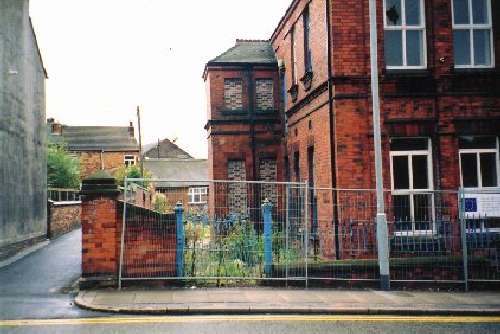 My first introduction to the school was on a September morning in 1958,
at 10 o'clock if memory serves me right. Fortunately there were 8 of us
from the same Junior School - Derek Johnson, Reggie Edwards, Robert
Gibbs, Robert Mackenzie, Terry Parker, Keith Dytor, Colin Roberts and
myself - so it wasn't nearly as daunting an experience as it might have
been. We spent some time milling about on the pavement, and befriended
Stu Smith, who was "one alone" from his previous school. I think we were
then herded into the passage way at the side of the buildings, then went
right, under the covered walkway, past the labs, with their
characteristic smell, and then probably into the Hall, for "allocation"
to our form rooms and masters.
My first introduction to the school was on a September morning in 1958,
at 10 o'clock if memory serves me right. Fortunately there were 8 of us
from the same Junior School - Derek Johnson, Reggie Edwards, Robert
Gibbs, Robert Mackenzie, Terry Parker, Keith Dytor, Colin Roberts and
myself - so it wasn't nearly as daunting an experience as it might have
been. We spent some time milling about on the pavement, and befriended
Stu Smith, who was "one alone" from his previous school. I think we were
then herded into the passage way at the side of the buildings, then went
right, under the covered walkway, past the labs, with their
characteristic smell, and then probably into the Hall, for "allocation"
to our form rooms and masters.
We went into 1 alpha (for the south end of the city boys) and had Mr.
Smith ('Biffo'), a chemistry teacher, as form master. He was also
starting his career at the school, and we had Office 2 (see Renovation
Plan), as our form room. I think that this was Room 2, and Office 1 was
Room 1, though it could have been "vice versa". In any event 1A had
Office 1 for their room. We were also introduced to the complexities of
the 6 day timetable, with eight lessons a day, and shown the place on the
Hall wall where the number of the day was displayed. (Later we would be
introduced to the ritual of being given the number of the day on which
shool would resume after a holiday) - though all this disappeared after
the full move to High Lane, which saw the school adopt a 7 period per
day, 5 day timetable.
I've only the vaguest of memories of lessons in the ground floor
classrooms at MR. We had a chemistry lesson in Office 2 and History with
Sifta in Office 1. He was the only master who demanded the class stand
up when he entered the room! This was modified when we moved to HL and
forms used to have their lessons in the History Room (his room) in which
case we were only allowed to sit down when he gave the word. Eccentric,
or a shrewd disciplinary measure? I never remember him either having
problems with a class or having to resort to corporal punishmnet - so
maybe it worked, although he was also a tall man, so perhaps that
helped.
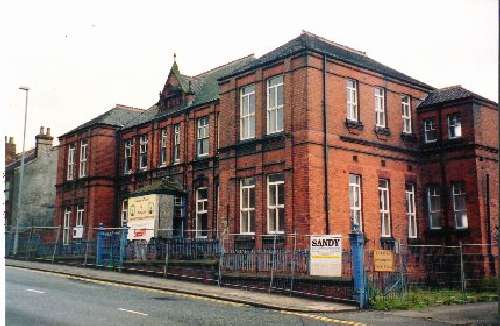
We had RE with Goofy in the Mechanics Lab (Pointon: what's a prepuce
Sir? ), but also Physics with Daddy Knight - the well-known
experiment of heating a horizontal bar, screw threaded at one end, with
a pin through a hole at the opposite, flattenened end, the bar supported
in a wide, shallow, U-frame. As the bar expands the nut is tightened,
and eventually a cold wet cloth is thrown (with some panache in Daddy's
case) onto the bar, and the pin snaps. Great stuff. No mask, goggles or
any protection. The HSE would have had a field day!!
Upstairs we had a lot of lessons in Office 6 - Room 6. Flush, Sifta,
Jonah (Punch) and Daddy Knight all come to mind. Mrs. Moran was in
Office 8. Again I cannot remember the numbering of the other rooms. We
had Daddy Knight in Room 5, Flush in the Burslem end of Suite 7 - where
Dave Shaw memorably asked if Flush sat members of 4 alpha on the cold
quarry floor of the kitchen before whacking them with the black pump he
carried round with him. (Always there - never used as far as I remember).
He said he didn't do that but thought it was a great idea. :-)
We had Geoff Allen (when we were in 2 alpha) in Office Suite 9 - for
French and for RE. I seem to remember some discussion about the
accession of Pope John after Pope Pious died, so that would be in 1960.
(Where were the blackboards loacted in Suites 5 and 9 - as both have
windows at each end and I'm sure we sat in rows across the width, rather
than the length of the rooms?).
Metalwork was taken across the yard in the LH of the two shops. At that
time we had "Roger" Johnson. Mr. George was master of the Machine Shop
with its array of belt-driven tools; what an industrial museum that
would have been if it had remained unchanged.
Metalwork followed Tech Drag which brings me to my other abiding(?)
memory of MR - the first encounter with Jack Berrisford, about whom
much has already been written. This event happened on the first Friday
afternoon - Day 6 on the timetable - so we must have started on Day 2.
We were assembled in the Hall, awaiting orders, and in strode this
imposing bloke in a white coat. "My God", I thought, "a medical!!". I
was terrified - I hated (and still do) - medicals. My relief on
discovering that it was Tech Drag was short lived as we spent the next
hour and a bit (it was a "double") being drilled in the horrors of the
levels of pain that could be inflicted with a well-wielded length of
Bunsen tubing! We were left in no doubt that if we could not recite his
six rules (a point has position but no size, a straight line has length
but neither breadth nor thickness, when a transversal crosses a pair of
parallel lines, the Corresponding Angles are equal, the Opposite Angles
are equal and the sum of the Adjacent Angles is 180 degrees, a pair of
parallel lines remain the same distance apart and do not meet, except at
infinity, ........ derrrrrr) by his next lesson then we would find out
what it would feel like. Absolutely terrifying.
At the time it was great to leave MR behind; but now I find myself
looking back on the place with some affection. It was certainly a place
full of character (and characters)
Previous Page
or
Top
The extended new school in High Lane was
officially opened by Harriet Slater, MP
on Tuesday 27th September 1960.
Contrary to popular belief the name change to Stanfield Technical High School did not coincide
with the move from Moorland Road to High Lane in September 1960.
A debate in 2002 finally concluded that the name change had been announced at about Easter of 1961.
The headings on the
School's 1961 Summer report form have an initially different variant of the name as "Stanfield Technical School".
This article appeared in the "The Evening Sentinel"
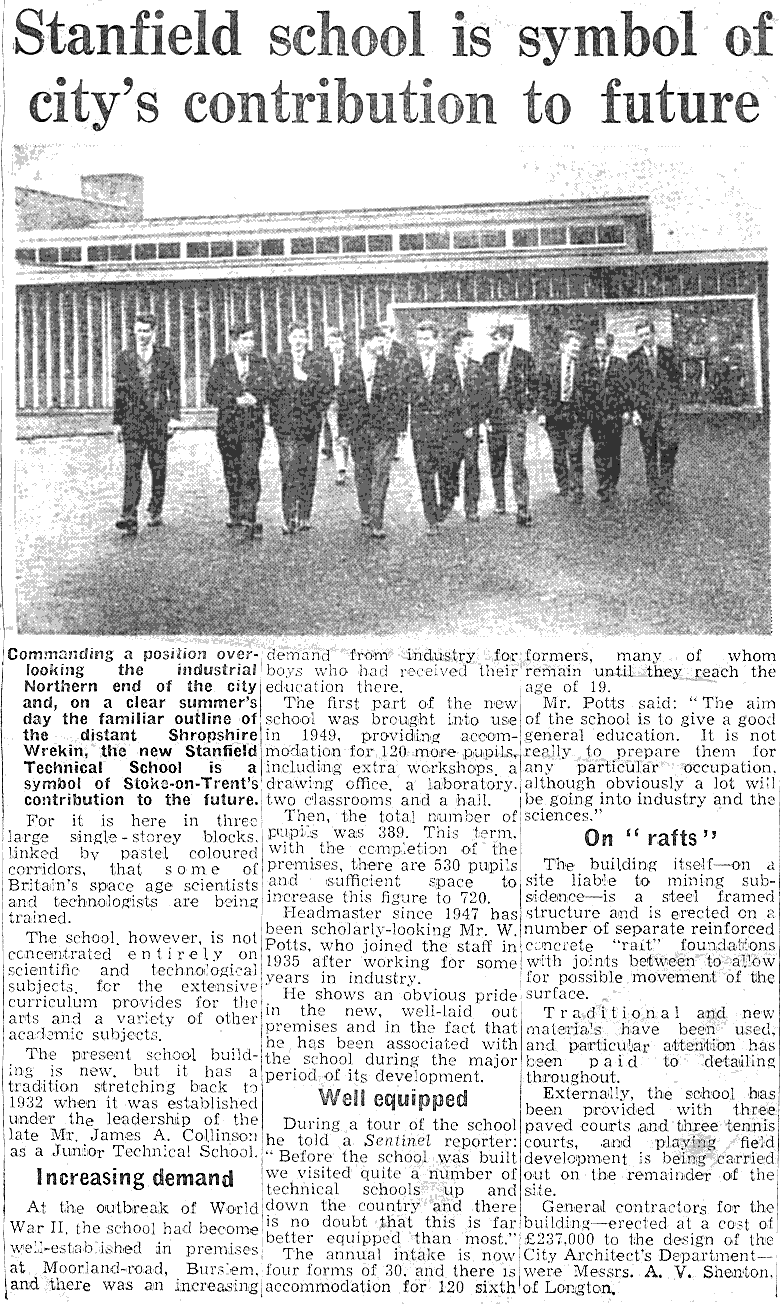
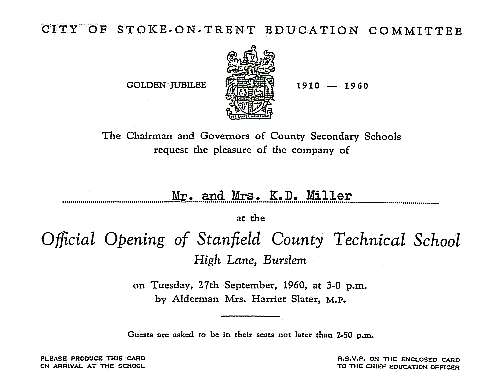
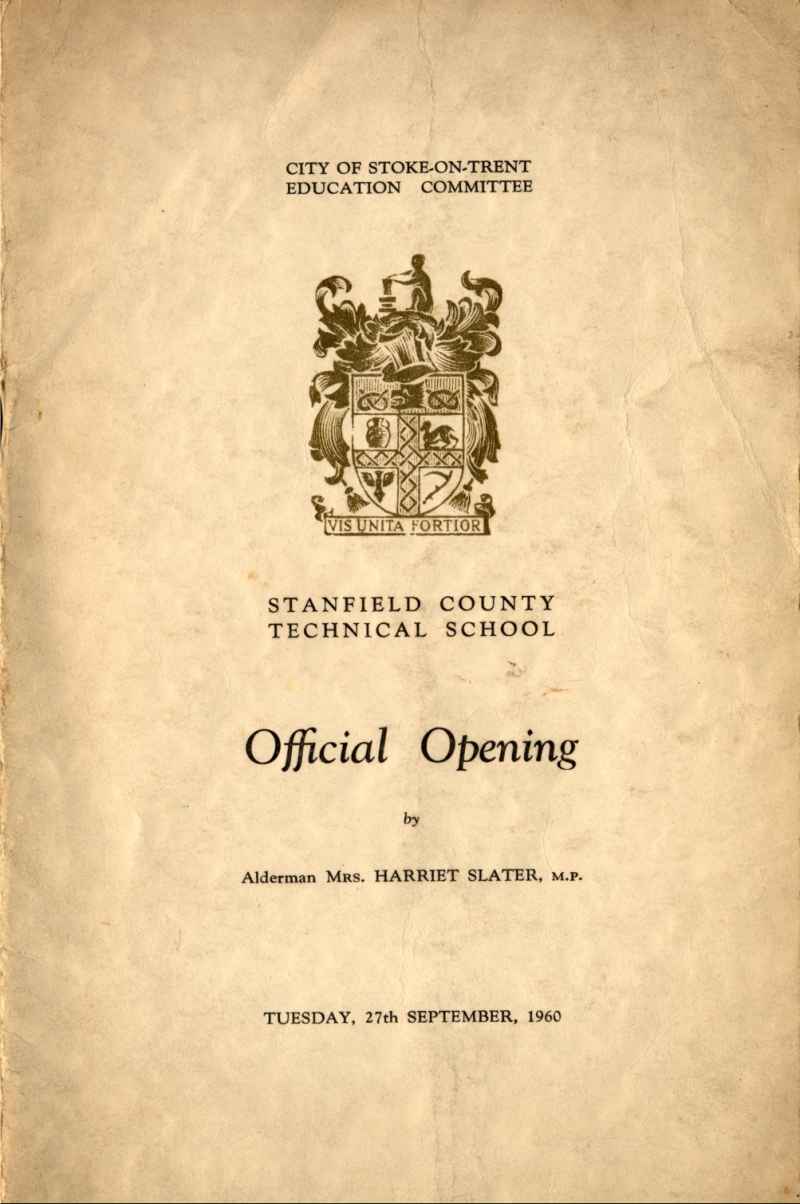
This extract is taken from
the "Official Opening" programme:
"The annual intake [in 1960] is now four forms of 30, and there is Sixth-form
accommodation for 120, giving a total of 720.
The aim of the school is now much broader than it was in 1932; although the
majority of leavers enter industry or a technical college or undertake
scientific or technical studies at University, some enter the
professions or university Arts courses and provision is made throughout
the school for both types of pupil."
Previous Page
or
Top
Memories of the school in 1959
Chris Horrobin (1959-66) has these recollections of his time at the School during the move to High Lane
In 1959-60 the School was still mostly housed in the old hospital buildings in Moorland Road. The High Lane concrete pre-fab buildings housed Art, Woodwork, Bricklaying & Plumbing, and extra PE/Games facilities.
The Moorland Road dusty, wood splintered, reception area acted as a multi-function assembly area, gym and dining hall.
The latter used rows of long trestle tables and wooden benches; those who were on fatigues were usually given a second helping of the "sweet". Boys with sandwiches were allowed to eat them at the Moorland Road cafe - by the old Burslem station - where a cup of a beverage resembling tea could be bought.
The Moorland Road toilets were an open-air block in the playground; a classic setting for junior contests as to who could pee highest against the black wall of the communal urinal.
There were no shower facilities after PE/Games on either site - a quick face and leg wash in cold water sufficed.
The chemistry lab was the old hospital pharmacy; metalwork was in the old mortuary.
Tech Drawing was in a garret room up several flights of narrow stairs and a queue would form outside the door.
"Jack" Berrisford would examine everyone's hands - back/front - and "dirty" meant a long walk all the way back down to the cloakroom. Tech drawing always seemed to follow a metalwork period! Shoes were also inspected and everyone would furiously clean them with their metalwork aprons. Someone failing the inspection would produce a chain reaction down the queue of boys furtively rubbing the tops of their shoes against the backs of their long socks.
Long trousers were not usual until the second form; a communal rite of passage that seemed to have disappeared by the 1963 School photograph.
The final move to High Lane in September 1960 was paradise
with all its modern facilities. The indooor toilets and the gym's mandatory
communal hot showers were a luxury to many pupils. Many homes still
had outside toilets and a "tin" bath in the scullery, or in front of the living room fire, once a week.
However - the hands/shoes ritual for Tech Drawing remained - and the
cloakrooms were still down two flights of the terraced stairs.
The much adored Mrs Bainbridge made school lunches that were real food - with extra chips for those she called "my boys" viz the VIth Form.
After-school clubs feasted on tea and slices of jam-custard tart at 1d a cup or slice.
Her early death was much mourned by the boys.
Previous Page
or
Top
Looking back
January was a most unhappy month for the school. On January 1st, C. T. Lownds of the Lower VIth died in hospital.
Christopher had suffered from ill health for many years but he was always cheerful and he was admired and liked by
both boys and staff.
On January 6th, Mr. Bailey, our assistant caretaker had a seizure in the school hall and died
later in the day in hospital. He had not been with us very long but he had made many friends in the school and his
death was a blow to us all.
Early in February, on Wednesday morning, February 8th, the whole school was stunned to hear that Mr. Baileff had
died during the night. A tribute to Mr. Baileff appears below.
New buildings
The year itself has been one of settling in and solving the teething problems to which all new buildings are prone. We
have not yet reached our full quota of boys and so we are not short of accommodation. The laboratories are now
almost complete and the library stock is slowly growing. Our outstanding problem is lack of a playing field but even
this is now taking shape. We shall have the 'all weather' football pitch at the end of the year and the field work,
including drainage, of the remainder of the grounds will be finished in the Spring, and the grass sown. It will most
likely be 1963 before we can play on it.
Sport and Societies
The following pages show that there has been as much sport played as usual and the number of societies has
increased. Theatre visits have continued with parties visiting the University College of North Staffordshire, the
Birmingham Repertory Theatre and the Mitchell Memorial Theatre. Throughout the year there has been a continuing
attendance of parties at outside lectures.
Parties went to:
The British Association meeting at Birmingham
The Faraday Lecture,
The Mitchell Memorial Lecture
Professor Parkinson's Lecture in the Jubilee Hall
and to a variety of
lectures arranged by the schools' societies, including the S.C.M. Manchester and Keele conferences, C.E.W.C. and
I.S.C.A. meetings, and meetings of the Mathematical and Geographical Societies.
In March the annual Prize Distribution took place in the Queen's Hall, Burslem, our visitor this year being Dr.
Astbury, Director of the British Ceramic Research Association.
Music
The music in the school has flourished, the school choirs performed very creditably on Speech Day and the
orchestra has played on Wednesday mornings at Assembly. Visits were made to several concerts in the Victoria
Hall and we welcomed a string quintet from the Halle Orchestra in October. Preparations are well in hand for the
carol services.
Trips and Excursions
In the Summer term after the toils of the General Certificate Of Education were over, a full house programme of
activities was carried out and a number of parties went on school excursions. During the Summer holiday Messrs.
Beresford and George and their wives took a party of boys to Switzerland
and towards the end of the holiday Mr.
Yates, Mr. George and Mr. Ernest took boys to the annual camp in Wales. On occasions there appeared to be
almost as many Staff visitors as campers.
General Certificate of Education results and College places
Our General Certificate of Education results last year were quite exceptional and we could not hope to maintain such
a high standard. This year the overall results were up to average of the examination, 525 papers being taken and 316
passes obtained, giving 60% passes. In some subjects the results were exceptionally high with Art, History and
Woodwork gaining more than 96% passes, and English Language, 90%, passes. At Advanced Level the results
were below average but here again they varied from subject to subject.
Our congratulations go to the following boys who obtained University entrance : Billington at Manchester, Scott,
Orme and Platt at Birmingham, Morlidge at Nottingham, and Bosson at Northampton College of Advanced
Technology. Bentley has gone to Cheltenham T.C., Hollins to Leicester T.C., Edwards to Nelson Hall T.C., and
Sherratt to Shoreditch T.C. We hope that they will all enjoy their three years at the Training Colleges.
The Christmas term has been as full as ever. The Dining Hall is busy most days after school providing tea and
biscuits for societies. The workshop block is a hive of industry most evenings; the Gym is well used after school; the
Dramatic Society is rehearsing for its annual play and the Science Society and the Sixth Form Society are meeting
regularly. The annual dance for the Sixth Form and the Old Boys has been arranged for Thursday, December 21st
and promises to be as successful as ever.
School Name Change
There remains one final item to report. The Education Committee has changed the name of the school to Stanfield
Technical High School. They believe that this is more in keeping with the advanced standard of the work which is
being done in the school and that the name brings us into line with the other two boys' high schools in the city.
Mr. Jim Baileff
The death of Mr. Baileff in February was a shock and tragedy for us all. He was a man who never spared himself, in
the belief that only the best was good enough. His patience, his untiring energy, and his readiness to lend a hand
have made his death a real loss to the school.
Those who knew him intimately as a man who loved his family and home, and a wide circle of friends, will greatly
miss him, though his influence will be felt for a long time.
We must extend our sympathy to Mrs. Baileff and her family, especially in view of her illness during the summer,
and hope that the future may hold some recompense for the sorrow of the past year.
1961
STAFF NEWS
The year has seen several Staff changes.
Mr. Edwards left us in July to become Headmaster of the Owler Lane Secondary Intermediate School , Sheffield. Mr.
Mountford has joined the English Staff of a modem school in Cambridge and left in July. Mrs. Thomas is leaving us
at the end of this term to join the Staff at the Clayton Hall School for Girls and Mr. Jones is going to Kidsgrove
Grammar School as Head of the English Department.
We thank them all for their hard work, both in and out of school and hope that they will be happy in their new
schools.
Mr. E. R. Kilfoil, B.Sc. and Mr. J. Burton, B.Sc. joined the Staff in September, Mr. Kilfoil from Hanley High School
and Mr. Burton from Leek High School. Mr. Kilfoil is the Head of the Department of Applied Mathematics and Mr.
Burton Head of the Chemistry Department..
Mr. J. J. Bromfield has joined the Mathematics Department, Mr. C. A. Lyas, B.A. and Mr. A. J. Fox have joined the
English Staff and Mr. A. Booth is taking Physical Education and English.
Mr. Twyford and Mr. Ernest rejoined the Staff and Mr. Allen, who was in charge of the French Department in Mr.
Twyford's absence, has now become Head of the newly constituted Department of General Studies.,
Miss D. Krenn has joined the Staff to take the French from Mrs. Thomas.
To all our new members of staff we extend a cordial welcome and hope that they will be happy with us.
Previous Page
or
Top
Late 1960s
With the retirement of the Headmaster Mr Potts (1967), the Deputy Head, Mr Howell (1968)
and the previous retirement on ill health grounds of the Head of English Mr Simnett (1965), the way was clear for some further changes.
These included another retirement, the old school hymn - "These things shall be! ".
This had been criticised as being too humanist by the Bishop of Stafford
(though not presumably by the Bishop of Kensington & Chelsea who was an old boy from the 1960s).
Other teachers whose faces were absent in the 1970s included
- Mr Allen (French),
- Mr Bancroft (Chemistry).
- Mr Berrisford (Tech Drawing),
- Mr Edwards (Maths - went to Sheffield),
- Mr Glover (PE),
- Mr Mills (Chemistry),
- Mr Taylor (Geography - RIP),
- Mr Taylor (Woodwork - retired)
- Mr Thomas (Maths)
- Mr Twyford (French)
- Mr Yates (Woodwork),
Previous Page
or
Top
"The Review" - 1968 Editorial
This extract is from the Editorial in
the 1968 School Magazine,
and talks of the changes planned to the school for 1970:
Editorial
The past year has seen some significant changes in the character of the Old
School and I suppose this is the best place to comment on them. Like
Teiresias in the Sophoclean tragedies, your editor is a permanent figure and
quasi-anonymous, enjoying a certain immunity when it comes to passing
judgment.
The Upper Sixth have settled in to their new freedoms, permission to wear
sober suits instead of school uniform, and a room of their own. After a week of
quickly suppressed flamboyancy of dress, they now appear quite respectable,
and one hopes that the novelty of having a Sixth Form Common-room will
eventually pass so that a tradition of reasonably quiet application to their
studies may begin.
The system of dual assemblies each morning, initiated by Mr. Potts, with
the Seniors having a religious programme of their own, has pleased everyone
and removed that awkward necessity of arranging a hundred chairs in the
Foyer. As the school will (miserabile dictu) lose its Lower Sixth and Upper
Sixth in 1970 because of the introduction of comprehensive education. this
split assembly is only a temporary measure, but it has given us the
opportunity of trying out a less traditional form of worship for the Seniors, a
form which seems to evoke considerable enthusiasm among them.
More pedestrian things have changed too. At mid-morning quiet cartons of
milk have replaced clanking bottles, and at midday the packed lunchers have
been persuaded to join the regular diners. New bus arrangements, with PMT
single-dockers and double-deckers in a line down Haywood Road have been a
great success and contributed visibly to road safety.
When the Day of Change occurs, in September 1970 according to present
calculations, we shall become mixed and have little girls running everywhere.
This means considerable building modification, so if you see gangs of
overalled young men knocking walls down and stealing cloakrooms, don't
think that the Sixth Formers have worn out their sober suits. It is just the New
Order. And I hope you like it.
Previous Page
or
Top
1970s - Change to Comprehensive School and loss of 6th Forms
By 1970 continuity of teachers from the 1960s was provided by:
- Mr Ballham (Physics)
- Mr Boon (Geography)
- Mr Burton (Chemistry)
- Mr Capey (Music)
- Mr George (Metalwork)
- Mr Goodwin (Biology)
- Mr Kilfoil (Maths)
- Mr Knight (Maths?)
- Mr Light (Art)
- Mr Nixon (Woodwork)
- Mr Salt (History)
Mark Lyttleton, (a pupil who joined in the late 1960s) says that
"The school became Comprehensive for the 1971 September term.
I have a feeling that there was no intake for 1970 September term,
and the mixed classes joined straight at 2nd year.
The Headmaster was John Lowe (known as Joe Lowe)
but I am struggling to remember who was deputy.
John Lowe went there for my initial term in September 1967.
Mr Howell (Tracker) was the Deputy but he was replaced by Mr Jolley
in 1968.
Mr Jolley died in the last 12-24 months, he used to play a high standard of cricket,
at County level (for Leicester I think)."
The school lost its Sixth Forms at the same time as the switch to the Comprehensive System.
Previous Page
or
Top
1980s
The school merged with Moorland Road in 1985 and became Haywood
High School. The pupils still called it "Stanners" though.
School uniforms changed in 1986 too. The Sixth Form had disappeared in 1970.
Previous Page
or
Top
2001 onwards
The 1967 School Magazine Editorial was surprisingly prescient.
about the old boys' School's ghostly presence in Derek Johnson's 2001 web site.
|
Let us now praise famous men,
and our fathers that begat us.
Such as did bear rule in their kingdoms,
men renowned for their power.
And some there be which have no memorial;
who are perished as though they had never been.
Their bodies are buried in peace;
but their name liveth for evermore.
Canticle
Songs of Praise 432
|
 My first introduction to the school was on a September morning in 1958,
at 10 o'clock if memory serves me right. Fortunately there were 8 of us
from the same Junior School - Derek Johnson, Reggie Edwards, Robert
Gibbs, Robert Mackenzie, Terry Parker, Keith Dytor, Colin Roberts and
myself - so it wasn't nearly as daunting an experience as it might have
been. We spent some time milling about on the pavement, and befriended
Stu Smith, who was "one alone" from his previous school. I think we were
then herded into the passage way at the side of the buildings, then went
right, under the covered walkway, past the labs, with their
characteristic smell, and then probably into the Hall, for "allocation"
to our form rooms and masters.
My first introduction to the school was on a September morning in 1958,
at 10 o'clock if memory serves me right. Fortunately there were 8 of us
from the same Junior School - Derek Johnson, Reggie Edwards, Robert
Gibbs, Robert Mackenzie, Terry Parker, Keith Dytor, Colin Roberts and
myself - so it wasn't nearly as daunting an experience as it might have
been. We spent some time milling about on the pavement, and befriended
Stu Smith, who was "one alone" from his previous school. I think we were
then herded into the passage way at the side of the buildings, then went
right, under the covered walkway, past the labs, with their
characteristic smell, and then probably into the Hall, for "allocation"
to our form rooms and masters.



